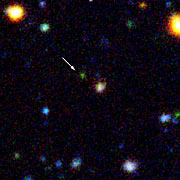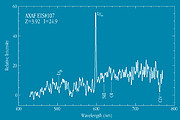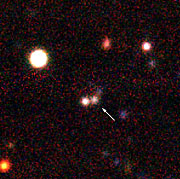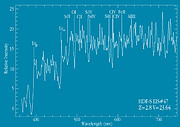Lehdistötiedote
VLT Studies Very Distant Galaxies
FORS Takes Spectra of Faint Primordial Objects
27. helmikuuta 1999
Continuing progress in astronomical technology is opening new possibilities for the study of the distant universe. One of the most exciting, recent additions to this branch of astrophysics, known as cosmology, has been the discovery of a large population of galaxies in the primordial Universe in which intensive star-formation is going on. They are so distant (their redshifts are larger than 3 [1]) that the corresponding look-back time is over 90% of the age of the Universe, now estimated at about 14 - 15 billion years (1 billion = 1,000 million). We observe these objects as they were, when the Universe was between 1 and 2 billion years old. The investigation of the early Universe is one of the primary scientific goals that have motivated the construction of the ESO Very Large Telescope and its very diverse complement of instrumentation. The aim of these studies is to extend the observations of basic properties of galaxies to objects at the largest possible distances and hence the earliest possible epochs. We would like to learn as much as possible about these very faint galaxies, including their numbers and hence their space density, as well as their brightness, colours, sizes and shapes. What are the rates with which stars are formed in different galaxies at different epochs, what is their chemical composition and mass? How do they move in space and how do they cluster?
New spectra show properties of very distant galaxies
During the recent commissioning and science verification of the Focal Reducer/low dispersion Spectrograph (FORS) at the first 8.2-m VLT Unit Telescope (UT1), spectra were taken of several objects, thought to be high-redshift galaxies. These targets were located in two southern sky fields, known the Hubble Deep Field South and the AXAF Deep Field . The first of these has been extensively studied by means of images obtained with the Hubble Space Telescope; some VLT exposures of this sky field were also made, cf. e.g. eso9812. The other field will be observed with the new satellite AXAF X-ray observatory (now baptized "Chandra") that will be launched soon.
For these VLT observations, the selection of the targets was made by means of very deep images, obtained in several optical bands at the ESO New Technology Telescope (NTT) at the La Silla Observatory, within the ESO Imaging Survey (EIS). Distant high-redshift galaxies have peculiar colours - mostly unusually red - that help to distinguish them from the much more numerous, nearer galaxies. However, there are other objects that have similar colours, and only a spectrum will tell the true nature of the object.
These objects are extremely faint and their spectra can only be observed with very large telescopes like the VLT and a highly efficient spectrograph. The near-infrared (I) magnitudes of the objects studied during the present test observations ranged between 23.4 and 25.5, or between 10 and 65 million times fainter than what can be seen with the unaided eye.
As predicted, a large fraction of the spectra obtained turned out to be those of extremely distant galaxies, in the redshift range between z = 2.8 - 4.0.
Examples of FORS observations
Here are some examples of the new FORS spectral observations of distant galaxies, including two at redshifts z = 2.8 and 3.9.
Outlook
These observations demonstrate the great capability of the ESO VLT to peer into the remotest realms of the Universe and its potential to contribute to the study of the physical processes that took place at the time of the formation and evolution of the first structures. These new data will also allow future visiting astronomers to optimize their use of the VLT and FORS for observations of extremely faint and remote objects.
Not least, they will also help to improve the selection of future targets for spectral observations by refining the multicolour selection criteria from survey data.
Lisähuomiot
[1]: In astronomy, the redshift (z) denotes the fraction by which the lines in the spectrum of an object are shifted towards longer wavelengths. The observed redshift of a distant galaxy or quasar gives a direct estimate of the universal expansion (i.e. the `recession velocity'). Since this expansion rate increases with the distance, the velocity (and thus the redshift) is itself a function (the Hubble relation) of the distance to the object. The larger the distance, the longer it has taken the light from the object to reach us, and the larger is the "look-back" time, i.e. the fraction of the age of the Universe that has elapsed since the light we now receive, was emitted from the object.
Tiedotteesta
| Tiedote nr.: | eso9915 |
| Legacy ID: | Photo 12a-f/99 |
| Nimi: | AXAF Deep Field, EIS 107, EIS 47, EIS survey, Hubble Deep Field South, Spectrum |
| Tyyppi: | Early Universe : Galaxy Early Universe : Cosmology : Morphology : Deep Field |
| Facility: | New Technology Telescope, Very Large Telescope |
| Instruments: | FORS1 |
Our use of Cookies
We use cookies that are essential for accessing our websites and using our services. We also use cookies to analyse, measure and improve our websites’ performance, to enable content sharing via social media and to display media content hosted on third-party platforms.
ESO Cookies Policy
The European Organisation for Astronomical Research in the Southern Hemisphere (ESO) is the pre-eminent intergovernmental science and technology organisation in astronomy. It carries out an ambitious programme focused on the design, construction and operation of powerful ground-based observing facilities for astronomy.
This Cookies Policy is intended to provide clarity by outlining the cookies used on the ESO public websites, their functions, the options you have for controlling them, and the ways you can contact us for additional details.
What are cookies?
Cookies are small pieces of data stored on your device by websites you visit. They serve various purposes, such as remembering login credentials and preferences and enhance your browsing experience.
Categories of cookies we use
Essential cookies (always active): These cookies are strictly necessary for the proper functioning of our website. Without these cookies, the website cannot operate correctly, and certain services, such as logging in or accessing secure areas, may not be available; because they are essential for the website’s operation, they cannot be disabled.
Functional Cookies: These cookies enhance your browsing experience by enabling additional features and personalization, such as remembering your preferences and settings. While not strictly necessary for the website to function, they improve usability and convenience; these cookies are only placed if you provide your consent.
Analytics cookies: These cookies collect information about how visitors interact with our website, such as which pages are visited most often and how users navigate the site. This data helps us improve website performance, optimize content, and enhance the user experience; these cookies are only placed if you provide your consent. We use the following analytics cookies.
Matomo Cookies:
This website uses Matomo (formerly Piwik), an open source software which enables the statistical analysis of website visits. Matomo uses cookies (text files) which are saved on your computer and which allow us to analyze how you use our website. The website user information generated by the cookies will only be saved on the servers of our IT Department. We use this information to analyze www.eso.org visits and to prepare reports on website activities. These data will not be disclosed to third parties.
On behalf of ESO, Matomo will use this information for the purpose of evaluating your use of the website, compiling reports on website activity and providing other services relating to website activity and internet usage.
Matomo cookies settings:
Additional Third-party cookies on ESO websites: some of our pages display content from external providers, e.g. YouTube.
Such third-party services are outside of ESO control and may, at any time, change their terms of service, use of cookies, etc.
YouTube: Some videos on the ESO website are embedded from ESO’s official YouTube channel. We have enabled YouTube’s privacy-enhanced mode, meaning that no cookies are set unless the user actively clicks on the video to play it. Additionally, in this mode, YouTube does not store any personally identifiable cookie data for embedded video playbacks. For more details, please refer to YouTube’s embedding videos information page.
Cookies can also be classified based on the following elements.
Regarding the domain, there are:
- First-party cookies, set by the website you are currently visiting. They are stored by the same domain that you are browsing and are used to enhance your experience on that site;
- Third-party cookies, set by a domain other than the one you are currently visiting.
As for their duration, cookies can be:
- Browser-session cookies, which are deleted when the user closes the browser;
- Stored cookies, which stay on the user's device for a predetermined period of time.
How to manage cookies
Cookie settings: You can modify your cookie choices for the ESO webpages at any time by clicking on the link Cookie settings at the bottom of any page.
In your browser: If you wish to delete cookies or instruct your browser to delete or block cookies by default, please visit the help pages of your browser:
Please be aware that if you delete or decline cookies, certain functionalities of our website may be not be available and your browsing experience may be affected.
You can set most browsers to prevent any cookies being placed on your device, but you may then have to manually adjust some preferences every time you visit a site/page. And some services and functionalities may not work properly at all (e.g. profile logging-in, shop check out).
Updates to the ESO Cookies Policy
The ESO Cookies Policy may be subject to future updates, which will be made available on this page.
Additional information
For any queries related to cookies, please contact: pdprATesoDOTorg.
As ESO public webpages are managed by our Department of Communication, your questions will be dealt with the support of the said Department.






